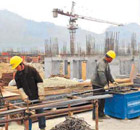Economy
China builds first sewage treatment plant on river to Russia
(Xinhua)
Updated: 2010-01-28 17:05
 |
Large Medium Small |
HARBIN: The first modern sewage treatment plant on the China section of the Suifen River, known as the Razdolnaya River in Russia, has begun operating, said a water affairs official in Dongning County, northeast China's Heilongjiang Province Thursday.
The Suifen River runs for 443 km, of which 258 km is in China, and empties into the Sea of Japan through Russia. There are no big cities on the upper stretches before it reaches Dongning, which has a population of 210,000.
The county bordering Russia produces about 9,000 tons of sewage on average a day, and 13,000 tons at the maximum, said Zhao.
He said the plant had a daily treatment capacity of 20,000 tons and it would be upgraded to 30,000 tons in the future.
He did not give the schedule of the plant's upgrading.
"The river water will reach China's best level of river water quality, after being processed by the plant," he said.
He said before the sewage treatment facility was built, the plant used chemicals to treat sewage in an oxidization pool before it was discharged into the river. The method could not effectively dispose of pollutants in the sewage.
The plant is built at a cost of 88.53 million yuan ($12.97 million) and construction began in May 2009. Its equipment is highly automated and only 14 staff are needed for the daily operation of the plant, said Zhao.












